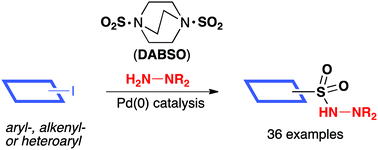Palladium-catalysed aminosulfonylation of aryl-, alkenyl- and heteroaryl halides: scope of the three-component synthesis of N-aminosulfonamides†
Abstract
By using DABCO·(SO2)2, DABSO, as a solid bench-stable SO2-equivalent, the

* Corresponding authors
a
Department of Chemistry, University of Oxford, Chemistry Research Laboratory, Mansfield Road, Oxford, OX1 3TA, UK
E-mail:
michael.willis@chem.ox.ac.uk
Fax: +44 (0) 1865 285002
b Oncology Innovative Medicines, AstraZeneca, Alderley Park, Macclesfield, Cheshire, SK10 4TG, UK
By using DABCO·(SO2)2, DABSO, as a solid bench-stable SO2-equivalent, the

 Please wait while we load your content...
Something went wrong. Try again?
Please wait while we load your content...
Something went wrong. Try again?
E. J. Emmett, C. S. Richards-Taylor, B. Nguyen, A. Garcia-Rubia, B. R. Hayter and M. C. Willis, Org. Biomol. Chem., 2012, 10, 4007 DOI: 10.1039/C2OB07034K
To request permission to reproduce material from this article, please go to the Copyright Clearance Center request page.
If you are an author contributing to an RSC publication, you do not need to request permission provided correct acknowledgement is given.
If you are the author of this article, you do not need to request permission to reproduce figures and diagrams provided correct acknowledgement is given. If you want to reproduce the whole article in a third-party publication (excluding your thesis/dissertation for which permission is not required) please go to the Copyright Clearance Center request page.
Read more about how to correctly acknowledge RSC content.
 Fetching data from CrossRef.
Fetching data from CrossRef.
This may take some time to load.
Loading related content
